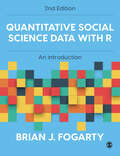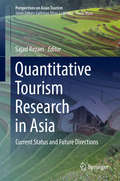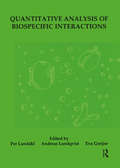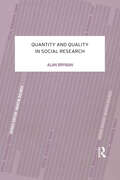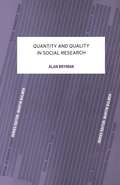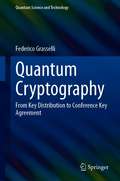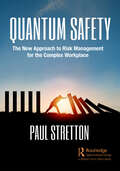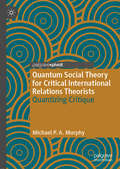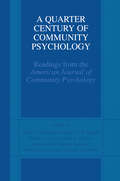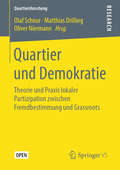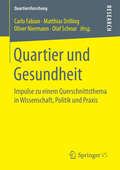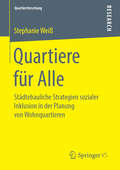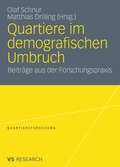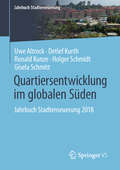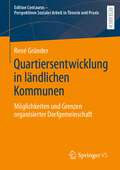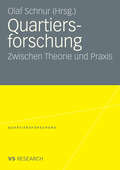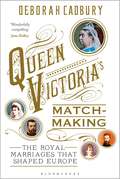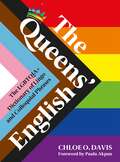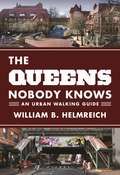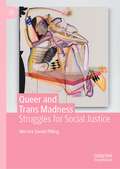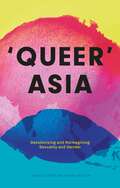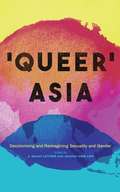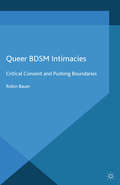- Table View
- List View
Quantitative Social Science Data with R: An Introduction
by Brian J FogartyRelevant, engaging, and packed with student-focused learning features, this book provides the basic step-by-step introduction to quantitative research and data every student needs. Gradually introducing applied statistics and the language and functionality of R and R Studio software, it uses examples from across the social sciences to show students how to apply abstract statistical and methodological principles to their own work. Maintaining a student-friendly pace, it goes beyond a normal introductory statistics book and shows students where data originates and how to: - Understand and use quantitative data to answer questions - Approach surrounding ethical issues - Collect quantitative data - Manage, write about, and share the data effectively Supported by incredible digital resources with online tutorials, videos, datasets, and multiple choice questions, this book gives students not only the tools they need to understand statistics, quantitative data, and R software, but also the chance to practice and apply what they have learned.
Quantitative Tourism Research in Asia: Current Status And Future Directions (Perspectives on Asian Tourism)
by Sajad RezaeiThe purpose of this book is twofold. First, this book is an attempt to map the state of quantitative research in Asian tourism and hospitality context and provide a detailed description of the design, implementation, application, and challenges of quantitative methods in tourism in Asia. Second, this book aims to contribute to the tourism literature by discussing the past, current and future quantitative data analysis methods.The book offers new insights into well-established research techniques such as regression analysis, but goes beyond first generation data analysis techniques to introduce methods seldom – if ever – used in tourism and hospitality research. In addition to investigating existing and novel research techniques, the book suggests areas for future studies. In order to achieve its objectives the analysis is split into three main sections: understanding the tourism industry in Asia; the current status of quantitative data analysis; and future directions for Asian tourism research.
Quantitive Analysis Of Biospec
by Per Lundahl Andreas Lundqvist Eva GreijerFirst published in 2004, this book collects several up-to-date methods for quantitative analysis of biospecific interactions, a field that has a long history that perhaps can be said to have begun with the classical paper of G. Scatchard in 1949 (The attractions of proteins for small molecules and ions, but which has advanced impressively during the last few years. A precise spatial arrangement of just a few hydrogen bonds can confer a remarkably specific reversible association between two molecules. A web of weak interactions governs biospecific recognition in general. The binding equilibria in living cells tune and coordinate a multitude of functions. The thermodynamic properties of such interactions are often studied by binding experiments in simplified and essentially ideal systems. However, similar types of studies may elucidate the biologically relevant dynamic steady-state conditions in living cells and organisms, allowing for the very wide range of interactant concentrations and the interplay between the many reactions and interactions. The development in biosciences will continue with in-depth studies of macromolecules and membranes. More detailed knowledge will allow analyses of delicate balances between substances and events in the complex systems involved in life processes. Methods to study biospecific affinities are thus highly important tools for understanding mechanisms and effects of molecular binding events in vivo and in vitro, e.g., in biochemical, biomedical and pharmaceutical research, and for biotechnological research and production.
Quantitive Analysis Of Biospec
by Per Lundahl; Andreas Lundqvist; Eva GreijerFirst published in 2004, this book collects several up-to-date methods for quantitative analysis of biospecific interactions, a field that has a long history that perhaps can be said to have begun with the classical paper of G. Scatchard in 1949 (The attractions of proteins for small molecules and ions, but which has advanced impressively during the last few years. A precise spatial arrangement of just a few hydrogen bonds can confer a remarkably specific reversible association between two molecules. A web of weak interactions governs biospecific recognition in general. The binding equilibria in living cells tune and coordinate a multitude of functions. The thermodynamic properties of such interactions are often studied by binding experiments in simplified and essentially ideal systems. However, similar types of studies may elucidate the biologically relevant dynamic steady-state conditions in living cells and organisms, allowing for the very wide range of interactant concentrations and the interplay between the many reactions and interactions. The development in biosciences will continue with in-depth studies of macromolecules and membranes. More detailed knowledge will allow analyses of delicate balances between substances and events in the complex systems involved in life processes. Methods to study biospecific affinities are thus highly important tools for understanding mechanisms and effects of molecular binding events in vivo and in vitro, e.g., in biochemical, biomedical and pharmaceutical research, and for biotechnological research and production.
Quantity and Quality in Social Research
by Alan BrymanFirst published in 1988. Routledge is an imprint of Taylor & Francis, an informa company.
Quantity and Quality in Social Research
by Alan BrymanFirst published in 1988. Routledge is an imprint of Taylor & Francis, an informa company.
Quantum Cryptography: From Key Distribution to Conference Key Agreement (Quantum Science and Technology)
by Federico GrasselliRising concerns about the security of our data have made quantum cryptography a very active research field in recent years. Quantum cryptographic protocols promise everlasting security by exploiting distinctive quantum properties of nature. The most extensively implemented protocol is quantum key distribution (QKD), which enables secure communication between two users. The aim of this book is to introduce the reader to state-of-the-art QKD and illustrate its recent multi-user generalization: quantum conference key agreement. With its pedagogical approach that doesn’t disdain going into details, the book enables the reader to join in cutting-edge research on quantum cryptography.
Quantum Safety: The New Approach to Risk Management for the Complex Workplace
by Paul StrettonThis book is the most comprehensive review of health and safety in half a century. Most organisational approaches to health and safety are based on the methodology developed during the 1970s, and despite the workplace changing beyond recognition since that time, these approaches have remained untouched. Quantum Safety will develop a new understanding fit for the modern workplace. Quantum Safety is an approach that is part of the "new view" debate. There have been a number of other new approaches to health and safety in recent years, and while they all have merit and improve understanding to help create the optimal, safe working environment, they have failed to significantly create the change desired. These approaches are often flawed at the philosophical or conceptual level or propose a solution without a pathway to implement the principles in safety-critical environments. Quantum Safety: The New Approach to Risk Management for the Complex Workplace is founded on a wholesale critical analysis of the conceptual foundations of health and safety before translating the revised principles into a tangible methodology. Central to the development of Quantum Safety is the application of Complexity Science. The traditional approach to health and safety is considered to be Newtonian – it uses linear models and deterministic analysis. Quantum Safety, due to the full consideration of Complexity Science, introduces multidimensional models and develops analysis based on probabilities. Crucially, this does not render Newtonian methodologies as worthless – in the same manner that Newtonian physics was able to take mankind to the moon, but required the quantum understanding within computers to make it possible – Quantum Safety provides the mechanisms to complete organisations’ safety-based journeys. The new mechanisms are fully developed for the reader at both macro and micro levels. How an organisation measures safety and what it values are reset and re-examined. How we investigate adverse events and the consequential actions taken with employees to develop a true Just Culture within a high-performing culture are also completely revised. Essentially, Quantum Safety creates a pathway for understanding health and safety in the complex modern world. To achieve that, new models are introduced to replace the dated, simple tools and a new language is developed to communicate this powerful approach. It will help propel an organisation from considering safety within a concept of industrialised failure avoidance to valuing safety as an integrated aspect of high performance.
Quantum Safety: The New Approach to Risk Management for the Complex Workplace
by Paul StrettonThis book is the most comprehensive review of health and safety in half a century. Most organisational approaches to health and safety are based on the methodology developed during the 1970s, and despite the workplace changing beyond recognition since that time, these approaches have remained untouched. Quantum Safety will develop a new understanding fit for the modern workplace. Quantum Safety is an approach that is part of the "new view" debate. There have been a number of other new approaches to health and safety in recent years, and while they all have merit and improve understanding to help create the optimal, safe working environment, they have failed to significantly create the change desired. These approaches are often flawed at the philosophical or conceptual level or propose a solution without a pathway to implement the principles in safety-critical environments. Quantum Safety: The New Approach to Risk Management for the Complex Workplace is founded on a wholesale critical analysis of the conceptual foundations of health and safety before translating the revised principles into a tangible methodology. Central to the development of Quantum Safety is the application of Complexity Science. The traditional approach to health and safety is considered to be Newtonian – it uses linear models and deterministic analysis. Quantum Safety, due to the full consideration of Complexity Science, introduces multidimensional models and develops analysis based on probabilities. Crucially, this does not render Newtonian methodologies as worthless – in the same manner that Newtonian physics was able to take mankind to the moon, but required the quantum understanding within computers to make it possible – Quantum Safety provides the mechanisms to complete organisations’ safety-based journeys. The new mechanisms are fully developed for the reader at both macro and micro levels. How an organisation measures safety and what it values are reset and re-examined. How we investigate adverse events and the consequential actions taken with employees to develop a true Just Culture within a high-performing culture are also completely revised. Essentially, Quantum Safety creates a pathway for understanding health and safety in the complex modern world. To achieve that, new models are introduced to replace the dated, simple tools and a new language is developed to communicate this powerful approach. It will help propel an organisation from considering safety within a concept of industrialised failure avoidance to valuing safety as an integrated aspect of high performance.
Quantum Social Theory for Critical International Relations Theorists: Quantizing Critique (Palgrave Studies in International Relations)
by Michael P. MurphyThis book examines the crossroads of quantum and critical approaches to International Relations and argues that these approaches share a common project of uncovering complexity and uncertainty. The “quantum turn” in International Relations theory has produced a number of interesting insights into the complex ways in which our assumptions about the physics of the world around us can limit our understanding of social life. While critique is possible within a Newtonian social science, core assumptions of separability and determinism of classical physics impose limits on what is imaginable. The author argues that by adopting a quantum imaginary, social theory can move beyond its Newtonian limits, and explore two methods for quantizing conceptual models—translation and application. This book is the first introductory book to quantum social theory ideas specifically intended for an audience of critical International Relations.
A Quarter Century of Community Psychology: Readings from the American Journal of Community Psychology
by Tracey A. Revenson Anthony R. D’Augelli Sabine E. French Diane L. Hughes David Livert Edward Seidman Marybeth Shinn Hirokazu YoshikawaThis work contains original research from the first 25 years of the American Journal of Community Psychology, selected to reflect community psychology's rich tradition of theory, empirical research, action, and innovative methods. This volume will be of interest to community mental health workers, social science and social work researchers, health care professionals, policymakers, and educators in the fields of community and preventative psychology.
Quartier und Demokratie: Theorie und Praxis lokaler Partizipation zwischen Fremdbestimmung und Grassroots (Quartiersforschung)
by Olaf Schnur Matthias Drilling Oliver NiermannDie Beiträge dieses Open-Access-Bandes bringen demokratietheoretische Fragestellungen mit partizipatorischen Erfahrungen aus Quartieren zusammen. Charakteristisch für viele partizipative Planungsmodi ist ihr sozialräumlicher Kontext – das Quartier. Über dessen Mehrwert für gelingende Demokratie ist jedoch nur wenig bekannt: Während mit partizipativen Verfahren auf der Quartiersebene versucht wird, möglichst viele Menschen zu erreichen und so die Demokratie zu stärken, gibt es vor Ort Initiativen, die die Quartiersentwicklung als Koproduzierende stärker aktiv mitbestimmen möchten. Konflikte – und damit Anlässe für demokratische Momente – sind vorprogrammiert, wenn externe Interessen auf lokale Bedürfnisse stoßen. Dieses Buch bietet dazu vielfältige Erkenntnisse aus Wissenschaft und Praxis.
Quartier und Gesundheit: Impulse zu einem Querschnittsthema in Wissenschaft, Politik und Praxis (Quartiersforschung)
by Carlo Fabian Matthias Drilling Oliver Niermann Olaf SchnurDie Beitragsautoren dieses Bandes thematisieren das Quartier in seiner zunehmend wichtigen Funktion für die Gesundheit der Bevölkerung. Sie gehen der Frage nach, wie die Verbindung zwischen Quartiersentwicklung und Gesundheitsförderung konzeptualisiert werden kann, denn eine systematische Betrachtung dieses Verhältnisses ist bislang selten erfolgt. Dabei spielt der sowohl aus der Politik als auch der Praxis und den Gesundheitswissenschaften favorisierte Setting-Ansatz eine tragende Rolle. Das Buch liefert Perspektiven aus Theorie und Praxis sowie Interpretationen aus unterschiedlichen Disziplinen.
Quartiere für Alle
by Stephanie WeißStephanie Weiß untersucht erstmals das Konzept Design für Alle als Strategie sozialer Inklusion auf der Quartiersebene. Das Inklusionskonzept wird von der Autorin empirisch anhand von drei Fallstudien zu Wohnquartieren in Deutschland, Österreich und der Schweiz überprüft. In der Kombination aus städtebaulichen und sozialplanerischen Kriterien erweitert sie das Konzept und arbeitet Perspektiven für ein inklusives Quartier für Alle heraus. Dabei verschränkt die Autorin Raum-, Design- und Inklusionstheorien und verknüpft die Theoriekonzepte des französischen Soziologen Henri Lefebvre und des Schweizer Architektur- und Planungstheoretikers Lucius Burckhardt.
Quartiere im demografischen Umbruch: Beiträge aus der Forschungspraxis (Quartiersforschung)
by Olaf Schnur Matthias DrillingQuartiersentwicklung im globalen Süden
by Uwe Altrock Detlef Kurth Ronald Kunze Holger Schmidt Gisela SchmittDie Texte des Bandes befassen sich schwerpunktmäßig mit den Erfahrungen der Quartiersentwicklung im Globalen Süden und der Frage, wie es gelingen kann, selbst in Situationen geringster Ressourcenverfügbarkeit und größter Not menschenwürdige Lebensbedingungen auf der Quartiersebene zu verwirklichen. Von diesen Beispielen können wir für unsere eigenen Herausforderungen auf unterschiedlichste Weise profitieren: zum einen in methodischer Hinsicht, stellen sie doch höchste Anforderungen an die Mobilisierung von Selbsthilfekräften und die Beteiligung von Bewohnerinnen und Bewohnern, wenn sie überhaupt ernsthaft an einer schrittweisen Aufwertung interessiert sind; zum anderen hinsichtlich des Umgangs mit den Einflüssen des globalen und lokalen Immobilienkapitals, das auf eine maximale Verwertung insbesondere von günstig gelegenen Lagen mit Quartieren geringer Dichte und immobilienwirtschaftliche Erträge abzielt und dabei nicht selten die Lebensbedingungen der ärmsten Städter fundamental in Frage stellt.
Quartiersentwicklung in ländlichen Kommunen: Möglichkeiten und Grenzen organisierter Dorfgemeinschaft (Edition Centaurus - Perspektiven Sozialer Arbeit in Theorie und Praxis)
by René GründerDas Konzept der Quartiersentwicklung entstand in einem großstädtischen Kontext. Mit der Annäherung der Lebenswelten von Menschen in städtischen und ländlichen Kommunen, wird diese sozialräumliche Strategie aber auch für kleinere Städte und Gemeinden interessant. Was bei der Übertragung von Quartiersentwicklungsansätzen auf die Besonderheiten des ländlichen Raumes zu bedenken ist und welche Chancen sowie Herausforderungen dies für die Gestaltung zukunftsfähiger Dorfgemeinschaften bedeutet, wird in diesem Buch auf Grundlage von Theorie und Forschungsergebnissen praxisbezogen dargestellt.
Quartiersforschung: Zwischen Theorie und Praxis (Quartiersforschung)
by Olaf SchnurDie Autoren aus verschiedenen wissenschaftlichen Disziplinen und der Praxis zeigen unter den Schwerpunkten „theoretische Perspektiven auf das Quartier“, „Prozesse, Steuerung und Governance im Quartierskontext“ und „Quartiere im soziodemographischen Wandel“ wichtige Themenfelder einer intensivierten Quartiersforschung auf.
Queen Victoria's Matchmaking: The Royal Marriages that Shaped Europe
by Deborah CadburyA captivating exploration of the role in which Queen Victoria exerted most international power and influence: her role as matchmaking grandmother In the late nineteenth century, Queen Victoria had over thirty surviving grandchildren. To maintain and increase power in Europe, she hoped to manoeuvre them into dynastic marriages. In her sights was royalty from across the world. Yet for all their seeming obedience, her grandchildren often had plans of their own, plans fuelled by strong wills and romantic hearts. Her matchmaking plans were only further complicated by their coinciding with tumultuous international upheavals; revolution and war were in the air and after her death, her most carefully laid plans fell to ruin. Queen Victoria's Matchmaking travels through the most glittering, decadent palaces of Russia and Europe, weaving in scandals, political machinations and family tensions, to enthralling effect. It is at once an intimate portrait of the royal family and an examination of the conflict caused by the power, love and duty that shaped the marriages that Queen Victoria arranged. At the heart of it all is Queen Victoria herself: doting grandmother one moment, determined manipulator the next.
The Queens' English: The LGBTQIA+ Dictionary of Lingo and Colloquial Expressions
by Chloe O. DavisA landmark reference guide to the LGBTQIA+ community's contributions to the English language-an intersectional, inclusive illustrated glossary featuring more than 800 terms created by and for queer culture.With a foreword from Paula Akpan Do you know where "yaaaas queen!" comes from? Do you know the difference between a bear and a wolf? Do you know what all the letters in LGBTQIA+ stand for? The Queens' English is a comprehensive guide to modern gay slang, queer theory terms, and playful colloquialisms that define and celebrate LGBTQIA+ culture. This modern dictionary provides an in-depth look at queer language, from terms influenced by celebrated lesbian poet Sappho and from New York's underground queer ball culture in the 1980s to today's celebration of RuPaul's Drag Race. The glossary of terms is supported by full-color illustrations and photography throughout, as well as real-life usage examples for those who don't quite know how to use "kiki," "polysexual," or "transmasculine" in a sentence. A series of educational lessons highlight key people and events that shaped queer language; readers will learn the linguistic importance of pronouns, gender identity, Stonewall, the Harlem Renaissance, and more. For every queen in your life-the men, women, gender non-conforming femmes, butches, daddies, and zaddies-The Queens' English is at once an education and a celebration of queer history, identity, and the limitless imagination of the LGBTQIA+ community.
The Queens Nobody Knows: An Urban Walking Guide
by William B. HelmreichThe only neighborhood-by-neighborhood guide to New York City's largest borough, from the award-winning author of The New York Nobody KnowsBill Helmreich walked every block of New York City—some six-thousand miles—to write the award-winning The New York Nobody Knows. Later, he re-walked most of Queens—1,012 miles in all—to create this one-of-a-kind walking guide to the city's largest borough, from hauntingly beautiful parks to hidden parts of Flushing's Chinese community. Drawing on hundreds of conversations he had with residents during his block-by-block journey through this fascinating, diverse, and underexplored borough, Helmreich highlights hundreds of facts and points of interest that you won't find in any other guide.In Bellerose, you'll explore a museum filled with soul-searing artwork created by people with mental illness. In Douglaston, you'll gaze up in awe at the city's tallest tree. In Corona, you'll discover the former synagogue where Madonna lived when she first came to New York. In St. Albans, you'll see the former homes of jazz greats, including Count Basie, Ella Fitzgerald, and Billie Holiday. In Woodhaven, you'll walk a block where recent immigrants from Mexico, Guyana, and China all proudly fly the American flag. And much, much more.An unforgettably vivid chronicle of today's Queens, the book can be enjoyed without ever leaving home—but it's almost guaranteed to inspire you to get out and explore this captivating borough.Covers every one of Queens's neighborhoods, providing a colorful portrait of their most interesting, unusual, and unfamiliar people, places, and thingsEach neighborhood section features a brief overview and history; a detailed, user-friendly map keyed to the text; photographs; and a lively guided walking tourDraws on the author's 1,012-mile walk through every Queens neighborhoodIncludes insights from conversations with hundreds of residents
Queer and Trans Madness: Struggles for Social Justice
by Merrick Daniel PillingThis book urges those invested in social justice for 2SLGBTQ people to interrogate the biomedical model of mental illness beyond the diagnoses that specifically target gender and sexual dissidence. In this first comprehensive application of Mad Studies to queer and trans experiences of mental distress, Pilling advances a broad critique of the biomedical model of mental illness as it pertains to 2SLGBTQ people, arguing that Mad Studies is especially amenable to making sense of queer and trans madness. Based on empirical data from two qualitative research studies, this book includes analyses of inpatient chart documentation from a psychiatric hospital and interviews with those who have experienced distress. Using an intersectional lens, Pilling critically examines what constitutes mental health treatment and the impacts of medical strategies on mad queer and trans people. Ultimately, Queer and Trans Madness: Struggles for Social Justice explores the emancipatory promise of queer and trans madness, advocating for more resources to respond to crisis and distress in ways that are non-coercive, non-carceral, and honour autonomy as well as interdependence within 2SLGBTQ communities.
Queer Asia: Decolonising and Reimagining Sexuality and Gender
by J Daniel Luther Jennifer Ung LohQueer studies is now a rapidly expanding field, as scholars from a variety of disciplines seek to address the long-running marginalisation of queer perspectives and experiences. But there has so far been little effort to unify the study of queer communities outside the West, and much of the current writing views these communities through a narrowly Western lens.Building on the work of the annual Queer Asia conference, which the editors helped to establish, this collection represents the most comprehensive work to date on queer studies in an Asian context. Featuring case studies and original research from across the continent, covering the Middle East, South and East Asia, and Asian diasporas, the collection offers a genuinely pan-Asian perspective which places queer Asian identities and movements in dialogue with each other, rather than within a Western framework.By considering how queerness is imagined within plural Asian experiences and contexts, the contributors show a that re-envisioning of 'queer' through Asian perspectives has the potential to challenge existing discourses and debates in the wider field of contemporary gender, sexuality, and queer studies.
Queer Asia: Decolonising and Reimagining Sexuality and Gender
by Matthew Waites J. Daniel Luther Jennifer Ung LohQueer studies is now a rapidly expanding field, as scholars from a variety of disciplines seek to address the long-running marginalisation of queer perspectives and experiences. But there has so far been little effort to unify the study of queer communities outside the West, and much of the current writing views these communities through a narrowly Western lens.Building on the work of the annual Queer Asia conference, which the editors helped to establish, this collection represents the most comprehensive work to date on queer studies in an Asian context. Featuring case studies and original research from across the continent, covering the Middle East, South and East Asia, and Asian diasporas, the collection offers a genuinely pan-Asian perspective which places queer Asian identities and movements in dialogue with each other, rather than within a Western framework.By considering how queerness is imagined within plural Asian experiences and contexts, the contributors show a that re-envisioning of 'queer' through Asian perspectives has the potential to challenge existing discourses and debates in the wider field of contemporary gender, sexuality, and queer studies.
Queer BDSM Intimacies: Critical Consent and Pushing Boundaries
by R. BauerBased on an extensive interview study with lesbian, transgender and queer BDSM practitioners, this book sheds new light on sexuality and current theoretical debates in gender and queer studies. It critically discusses practices of establishing consent, pushing boundaries, playing with gender and creating new kinds of intimacies and embodiments.
